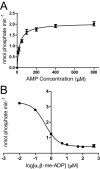Recombinant ecto-5'-nucleotidase (CD73) has long lasting antinociceptive effects that are dependent on adenosine A1 receptor activation
- PMID: 20398264
- PMCID: PMC2874211
- DOI: 10.1186/1744-8069-6-20
Recombinant ecto-5'-nucleotidase (CD73) has long lasting antinociceptive effects that are dependent on adenosine A1 receptor activation
Abstract
Background: Ecto-5'-nucleotidase (NT5E, also known as CD73) hydrolyzes extracellular adenosine 5'-monophosphate (AMP) to adenosine in nociceptive circuits. Since adenosine has antinociceptive effects in rodents and humans, we hypothesized that NT5E, an enzyme that generates adenosine, might also have antinociceptive effects in vivo.
Results: To test this hypothesis, we purified a soluble version of mouse NT5E (mNT5E) using the baculovirus expression system. Recombinant mNT5E hydrolyzed AMP in biochemical assays and was inhibited by alpha,beta-methylene-adenosine 5'-diphosphate (alpha,beta-me-ADP; IC50 = 0.43 microM), a selective inhibitor of NT5E. mNT5E exhibited a dose-dependent thermal antinociceptive effect that lasted for two days when injected intrathecally in wild-type mice. In addition, mNT5E had thermal antihyperalgesic and mechanical antiallodynic effects that lasted for two days in the complete Freund's adjuvant (CFA) model of inflammatory pain and the spared nerve injury (SNI) model of neuropathic pain. In contrast, mNT5E had no antinociceptive effects when injected intrathecally into adenosine A1 receptor (A1R, Adora1) knockout mice.
Conclusion: Our data indicate that the long lasting antinociceptive effects of mNT5E are due to hydrolysis of AMP followed by activation of A1R. Moreover, our data suggest recombinant NT5E could be used to treat chronic pain and to study many other physiological processes that are regulated by NT5E.
Figures




References
-
- Eltzschig HK, Ibla JC, Furuta GT, Leonard MO, Jacobson KA, Enjyoji K, Robson SC, Colgan SP. Coordinated adenine nucleotide phosphohydrolysis and nucleoside signaling in posthypoxic endothelium: role of ectonucleotidases and adenosine A2B receptors. J Exp Med. 2003;198(5):783–796. doi: 10.1084/jem.20030891. - DOI - PMC - PubMed
Publication types
MeSH terms
Substances
Grants and funding
LinkOut - more resources
Full Text Sources
Research Materials
Miscellaneous

